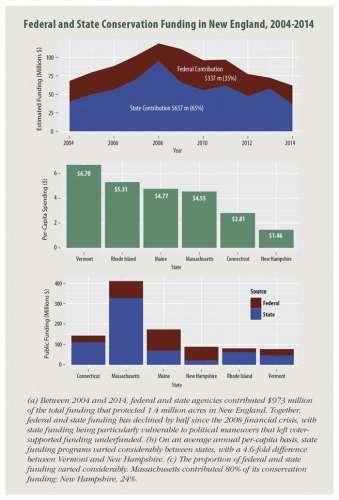
Harvard Forest released a report last week that’s been grabbing headlines – you can read it here. The big news is that between 1990 and 2010, New England lost 24,000 acres of forest each year to development. Paralleling this, the pace of land conservation slowed from about 150,000 acres a year in the early 2000s to about 50,000 acres a year since 2014.
Where it comes to the conservation piece, funding, of course, is the linchpin. The graphic here shows, as you might expect, a peak in federal and state conservation funding right before the recession, then a long-term slide since then. By my interpretation, this essentially says that when the economy was humming, fueled in large part by the shale gas and real estate booms, the conservation monies flowed in. According to Harvard, up to 80 percent of federal funds for New England land protection originate from programs under the Land and Water Conservation Fund, which relies primarily on royalties paid by oil and gas producers. State funds come from, among other sources, deed fees and real estate transfer taxes. And so the proverbial double-edged sword: when land is getting subdivided, and houses sprouting like mushrooms after a rain, and oil gushing, government coffers are flush, conservation programs are getting funded, and land conservation spikes. Forestland owners feel their own version of this: a booming economy and hot housing market can be great because it makes their wood more valuable, but it’s potentially not so great if it also means a development in the field across the road, an increase in local taxes to cover increased municipal services, a new crop of neighbors who don’t want to hear skidders or see log trucks.
Navigating this particular complexity, and about a thousand others, is going to be crucial if we want to reverse recent trends. As such, the report aims to fuel a conservation movement in New England. Harvard’s vision is that conservationists and willing landowners will permanently protect 70 percent of the New England landscape as forest by 2060. Most of this land would be managed land, with about a 10th being set aside for ecological reserves.
While recent trends are discouraging, progress has been made. According to the report, the rate of land protection over the past 25 years is four times higher than it was in previous decades, and since 2000, regional conservation partnerships have grown in number from 4 to 43 and have protected more than 300,000 acres of land.
If you’re inspired by the vision, check out their website and learn what you can do to help the cause.


Discussion *